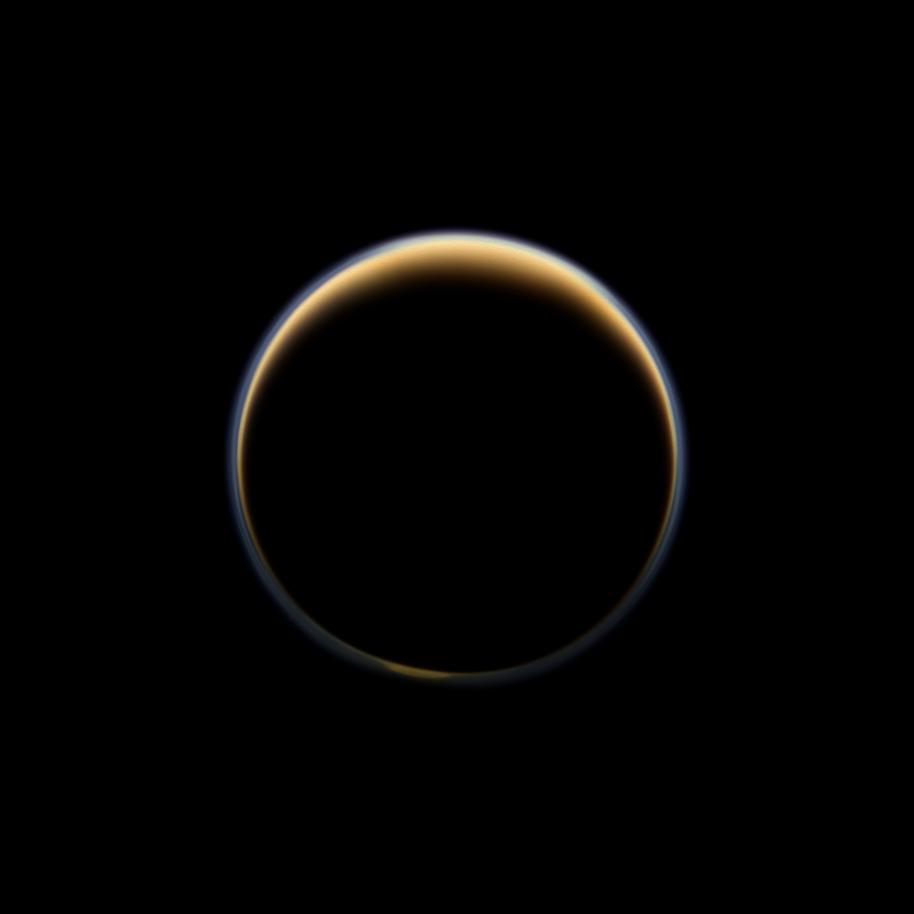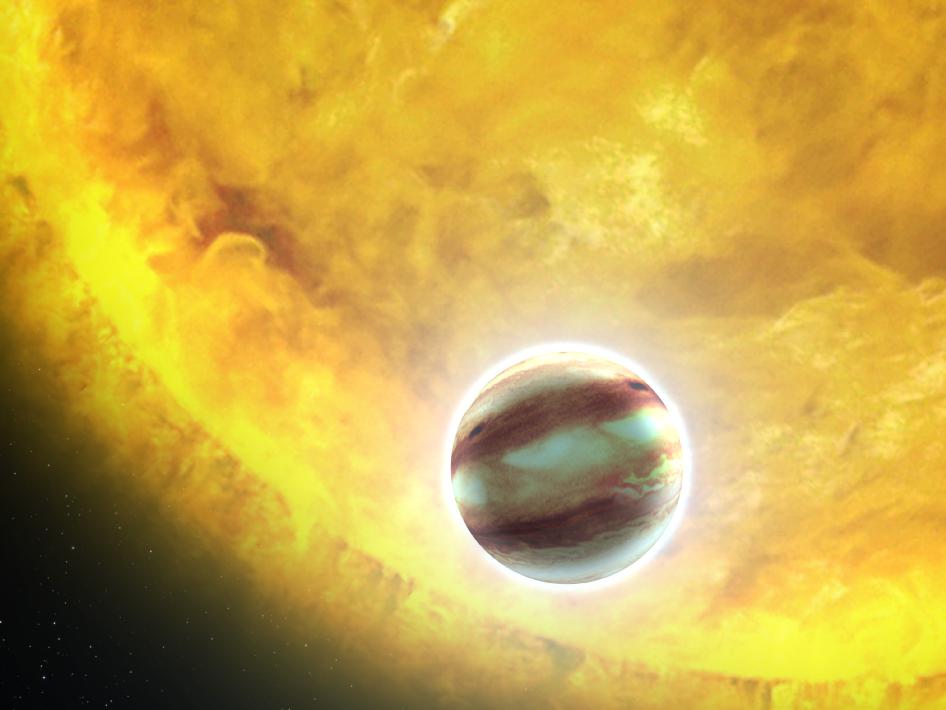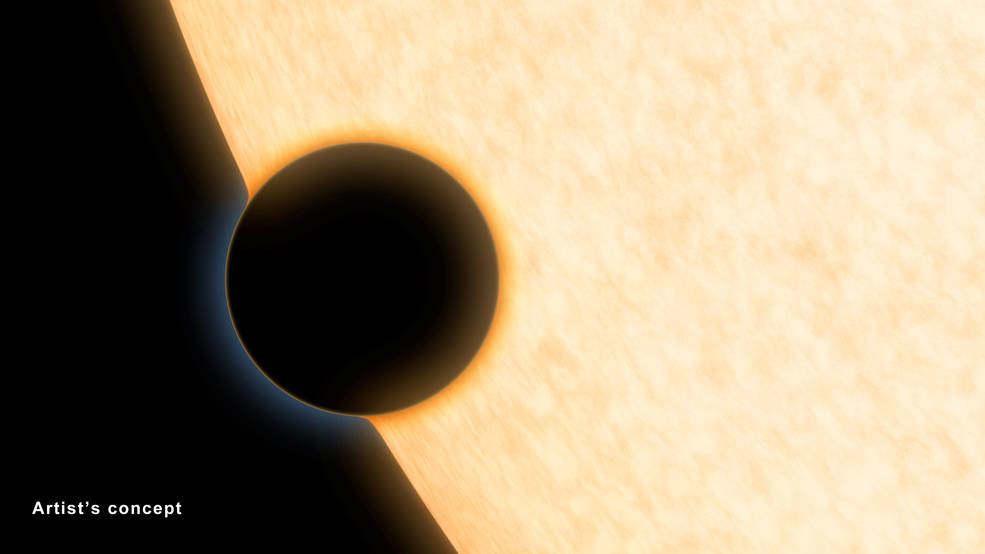How Studying Saturn Moon Titan Could Unlock Secrets of Alien Planets

With nearly 2,000 confirmed planets now known beyond our solar system, astronomers are attempting to identify the atmospheresof these distant bodies to determine if they could possibly host life.
But viewing a body so far away remains a challenge. Astronomers are honing their techniques in exoplanet observation using an object we know much more about in our own solar system — Saturn's largest moon, Titan. The process should help scientists better understand what a signal from a hazy planet that is similar to Titan would look like.
One of the problems with reading signals from the atmospheres of other planets is the difficulty in sorting out the differences between a thick cloud of smog-like haze from pockets of gas. At the same time, observers must contend with what astronomers call noise, extraneous signals not related to the planet they are studying. Whether it comes from material the light encounters along the way from the planet to Earth or from mechanical issues with the instruments, noise serves as static that may blur the actual readings. [The Strangest Alien Planets (Gallery)]
"Observers struggle with trying to distinguish haze signals from gas signals from noise," Tyler Robinson, of NASA's Ames Research Center in Moffett Field, California, told Astrobiology Magazine by email. "We've provided an almost noise-free dataset to help exoplanet observers better interpret their observations."
Robinson served as lead author on a study that used NASA's Saturn-orbiting Cassini spacecraft to examine Titan in a new way. The results were published in the journal Proceedings of the National Academy of Sciencesand presented at the winter meeting of the American Astronomical Societyin Seattle.
A haze-dominated 'planet'
As a distant planet passes in front of its star, light passes through the atmosphere. By studying that passage with a variety of wavelengths using a method known as transit spectroscopy, scientists can see how the signal changes with each observation and determine the composition of the atmosphere.

Some exoplanets have returned featureless readings, with no signs indicating atmospheric composition. To scientists, this suggests a high layer of clouds, or haze, in the atmosphere that absorbs the light from the star, blocking readings of the lower atmosphere that can tell scientists more about the planet's atmosphere and its potential habitability.
Get the Space.com Newsletter
Breaking space news, the latest updates on rocket launches, skywatching events and more!
"There is no problem detecting high-altitude cloud layers in the atmospheres of exoplanets — in fact, they're usually quite obvious," Heather Knutson, of the California Institute of Technology in Pasadena, told Astrobiology Magazine.
Knutson, who was not involved in the research, studies the physics and chemistry of exoplanet atmospheres.
"The real problem is that these cloud layers are hiding the atmospheric absorption signals we are trying to measure," she said. "In some cases, high-altitude clouds can make a small planet with a puffy, hydrogen-rich atmosphere look like it has a much more compact atmosphere made of heavier gases, such as water or carbon dioxide."
To understand how high-altitude hazes can affect the passage of light through the atmosphere, Robinson and his team used Cassini to study Titan. Using Cassini, they observed the sun rising and setting through the huge moon's atmosphere, a process known as occultation. For this setup, the spacecraft is located fairly close to the moon, while the source of light — the sun — is relatively far away. For exoplanet studies, the situation is reversed. The host star is relatively close to the planet, while observers on Earth are far away from the system.
"Occultations in the solar system and in the transits of exoplanets are perfectly complementary," Robinson said. "In both cases, the light that is transmitted through the atmosphere carries with it the spectral signatures of whatever gases, hazes, and clouds might be present in the planet's atmosphere."
Titan makes a perfect target for understanding hazy worlds, study team members said. The satellite is the haziest body in the solar system, with a nitrogen-rich upper atmosphere and clouds that send methane rain falling onto the surface of the planet.
"Although other solar system bodies have photochemical hazes, Titan is a great example of a body whose observable atmosphere is dominated by hazes," Knutson said. "It's also a nice object to study because it has a solid surface and a relatively thin atmosphere, and therefore might be a good analogue for a terrestrial exoplanet with a photochemical haze layer." [Our Solar System: A Photo Tour of the Planets]
The team found that the haze did a better job of blocking out blue light than red, rather than blocking all light equally as hazes were assumed to do. This means that exoplanets that were assumed to have Titan-like hazesbut returned flat, featureless spectra could actually have atmospheres dissimilar to that of the Saturn moon.
"For the worlds where our current best explanation for their flat spectra is a planet-wide haze layer, though, our observations show that Titan's haze isn't a good analogy for whatever makes up the haze on these distant worlds," Robinson said. "Some other kind of haze, with different properties for interacting with light, could explain the flat spectrum."

Another look
The solar system is filled with many types of worlds, and scientists have used them in the past to attempt to understand exoplanets. Frequently, however, they have done so by modeling the planets from a great distance, so that it appears only as a small point of light.
This method models how more exoplanets may be studied in the future, using a method known as direct imaging. Although most exoplanets today are studied using transit spectroscopy, no one had previously observed the transit spectra of solar system objects as points of comparison.Titan may be the best solar system example of a hazy body, but other worlds can offer insight into the variety of exoplanets scientists are likely to discover.
"Most solar system worlds have clouds or hazes of some types in their atmosphere," Robinson said. "By studying occultations — by, say, Venus or Saturn's atmosphere — in the solar system, we have an exciting opportunity to explore the variety of ways hazes and clouds can sculpt transit spectra."
This story was provided by Astrobiology Magazine, a web-based publication sponsored by the NASA astrobiology program. Follow Space.com @Spacedotcom, Facebook and Google+.
Join our Space Forums to keep talking space on the latest missions, night sky and more! And if you have a news tip, correction or comment, let us know at: community@space.com.

Nola Taylor Tillman is a contributing writer for Space.com. She loves all things space and astronomy-related, and enjoys the opportunity to learn more. She has a Bachelor’s degree in English and Astrophysics from Agnes Scott college and served as an intern at Sky & Telescope magazine. In her free time, she homeschools her four children. Follow her on Twitter at @NolaTRedd










